Government affairs
Legislative Updates
Despite the Voting Rights Act of 1965 ensuring eligible citizens could vote without prejudice, the reach and breadth of the act is still being interpreted and litigated nearly 50 years later. States throughout the country have enacted, or are in the process of enacting, a range of laws and policies making it harder to vote.
This wave of new policies doesn’t just require voters to show photo IDs, but also may require them to show proof of citizenship, reduce early and absentee ballot voting, end same-day voter registration, and restrict voting rights after incarceration.
In 2000, 36 states required no identification at the polls. Today, we see the exact opposite, with 34 states requiring voters to show some form of ID. Of these laws, 33 are in effect during the 2016 election cycle.
A report from the nonpartisan Brennan Center for justice estimates that more than 5 million voters could be affected by these laws.
Despite proponents of voter ID laws suggesting that these policies are preventing voter fraud, a five-year investigation by the Justice Department under President George W. Bush found just 86 instances of improper voting from 2002 to 2005.
Even worse, those who face the brunt of these discriminatory laws often are low-income workers, people of color and the elderly, since they often lack forms of identification and frequently do not have the means to get the necessary documentation for photo IDs.
As the 2016 general election draws closer, it’s important to make sure you have all the facts about your state’s laws on voting in advance. Check out the chart below to see where your state stands:

For more information on how voter ID laws unfairly affect millions of Americans, click here for a fact sheet by the AFL-CIO.



